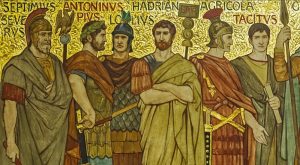Gnaeus Julis Agricola was born on the 13th of June in the year 40, in Gallia Narbonensis, in what is now modern-day Southern France. His mother was Julia Procilla, and his father, Lucius Julius Graercinus, was a member of the Roman Senate at the time of his birth. Agricola had influential grandfathers too, as both of them had served the empire as governors. Agricola received his education in Marseille and showed a deep interest in philosophy.
Early Life
Agricola started his career from 58 to 62, acting as a military tribune in Britain under the authority of Gaius Suetonius Paulinus. Upon returning to Rome, he married Domitia Decidiana, who belonged to a noble family. Her influence would later help Agricola in his political career.
Agricola and Domitia soon had a son, but shortly afterward, Agricola was sent to the province of Asiana to supervise public finance. During his time in Asiana, Domitia gave birth to their second child, Julia Agricola. Unfortunately, Agricola’s son died not long after this. In 68, the governor of Hispania called for Agricola to oversee temple treasures.
Rise to Power
During this period, Rome was in a state of unrest as a rebellion led by Galba threatened Nero. Terrified of being captured, Nero killed himself, resulting in a chaotic period in Roman history known as the Year of the Four Emperors. Galba took the throne, but he was eventually stabbed in the throat by one of Otho’s men. During these tumultuous days, Agricola’s mother was killed in her house by Othos’ rampaging army.
When Vespasian made public his intent to become emperor, Agricola jumped over to his side and offered support. Vitellius, who was commander of Germania Inferior and was making his own bid for the throne, defeated Otho about the same time. After this defeat, Otho, who had had enough of all the fighting and deaths, stabbed himself in the heart. Vespasian then assumed the imperial throne and assigned Agricola to Britain as the commander of Legio XX Valeria Victrix. As commander, Agricola showed his military skills in his clashes against ancient Britons, which impressed Britain’s governor, Quintus Petillius Cerialis.
Governor of Britain
In 73, Agricola’s tenure as commander ended, and he was transferred to Gallia Aquitania as governor. In 78, however, he was reassigned as governor of Britain, where he learned that Celtic tribes called the Ordovices had attacked Roman troops in north Wales. In retribution, Agricola hurled an attack against these tribes and defeated them. Two years later, he prepared his army to attack Scotland in an attempt to conquer the entirety of Britain.
In 83, Agricola pushed his troops deep into Scotland, the land of the Caledonians. This aggressive move was met with an equally aggressive act from the Caledonians, who attacked Roman troops during the night. Untroubled by the enemy’s staunch resistance, Agricola continued to march his troops deeper into the north. The Caledonians, however, were not to be lured into open battle and instead continued with their bush-fighting. When Agricola captured the Caledonian’s grain storehouses, things changed drastically. Now, Calgacus, the chief of the Caledonians, had to choose between confronting the Romans and letting his people starve. A battle now loomed between the two armies.
The Battle of Mons Graupius
The Roman troops led by Agricola and the Caledonians led by Calgacus met face to face in the year 84. Historians have suggested various locations where the battle took place, but the most probable one is Bennachie, a hilly area in Aberdeenshire. According to the historian Tacitus, 20,000 Romans stood opposite 30,000 Caledonians in what came to be known as the Battle of Mons Graupius.
The fighting began when spears flew from both sides. Roman auxiliary forces on the front surged uphill to initiate close combat with the enemy. The Caledonians were butchered in this portion of the battle, as their long swords with blunted tips and sharp edges were only good for slashing and, therefore, ineffective in close combat. Three thousand Roman soldiers on horseback continued the pressure by harassing the flanks of the Caledonians, causing them to break rank and run away in different directions.
Meanwhile, Agricola held in place the main force of the Roman army, numbering up to 9,000. According to Tacitus, 10,000 Caledonians lay dead, while Calgacus and 20,000 of his remaining men vanished in retreat. The historian further reports that only 360 Romans perished in the battle. Tacitus, though, had become Agricola’s son-in-law upon marrying Julia. He may have been more interested in magnifying the successes of his father-in-law rather than reporting the facts of the events. However, the Battle of Mons Graupius may indeed have been the closest that the Romans came to conquer the whole of Britain. Agricola might have sensed this, as after the battle, he sailed his ships around the waters of Scotland, perhaps to signal his control over the region.
Rumors of Domitian’s Envy
However, before Agricola could completely control Scotland, Emperor Domitian called him back to Rome. This was unfortunate for the empire, as subsequent governors of Britain were not as aggressive as Agricola and were merely content to maintain defensive fortifications. It was rumored that Domitian pulled out Agricola from Britain because the emperor’s military feats in Germany were being overshadowed by Agricola’s. Once on home soil, Agricola was welcomed by a public celebration and a statue built in his honor. Strangely, despite his proven capacity, he was never again appointed to any military position.
Death
Eight years after he was pulled out at the height of his military powers, Agricola died in his ancestral home in Gallia Narbonensis. There were rumors that he was poisoned by Domitian, but his death was most likely caused by ill-health.
